Malaysian GP: Technical Review
Here are the main technical innovations from the top teams in Sepang
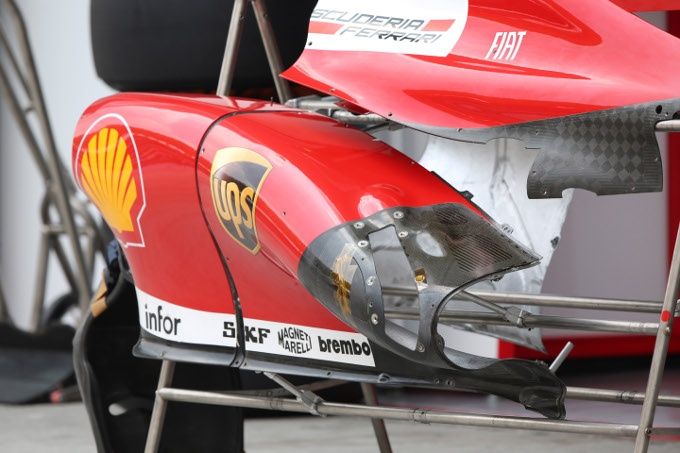
The Malaysian circuit, in terms of technical characteristics, is very different from the Melbourne city circuit. In addition to the technical characteristics of the track, the two circuits also differ due to the different climatic conditions.
The Sepang circuit requires excellent aerodynamic downforce and represents a great challenge both from an aerodynamic point of view, engine, brakes and above all for the tires which have become fundamental at this start of the season.
This GP took place just a week after the Melbourne GP. Usually, in such close races, it is difficult to see important technical updates but in this GP we saw something new.
Lotus
Lotus was very active, bringing a new front wing for both drivers while the new exhaust ramps were only used by Raikkonen. The new front wing is an evolution of the one introduced by the Lotus team in Barcelona during the last winter tests. The major difference between the two versions is the shape of the flaps on the outer end of the wing which are now divided into two small appendages.
New Lotus front wing
The new exhaust system has been fitted on Kimi Raikkonen's single-seater which includes a ramp that descends much faster than the previous version (see photo comparison below) and is also slightly shorter. You can also notice some changes to the tunnel under the exhausts which is used to bring part of the air flow coming from the sides towards the central part of the diffuser. With this exhaust configuration the tunnel has become taller and shorter.
The ramp solution, used by Lotus and Red Bull, is simpler to develop as the exhaust gases always have a support that leads them to the diffuser. This allows for greater stability of the car in the various speed phases, since the Coanda effect limits the transversal movement of the hot gases despite the interference of the aerodynamic flows coming from the front part of the car and from the upper part of the bellies.
This solution, unlike the bulb exhaust system used by other teams, has some limitations as the exhaust gases lose part of their energy as they "crawl" on the support ramps. The end result translates into less than optimal aerodynamic load on the rear diffuser.
Furthermore, the use of the ramp limits the useful surface for generating aerodynamic load only towards the final part of the diffuser (already almost in correspondence with the wheel). In fact, only there does the flow rest on the bottom of the diffuser.
McLaren
The Woking single-seater has slightly improved its performance compared to Australia although, seeing the car on the track, there are clear setup and balance problems.
The Mp4-28 seems to be very sensitive to ride height.
In fact, it became known that the time achieved by Button in Jerez was achieved due to a defect in the assembly of a component of the front suspension which had lowered the front of the car. Many will wonder: can they ride low from the ground then?
The answer is No, as they would not be able to comply with the FIA technical regulations which stipulate that the bottom does not wear out more than a set amount. Probably, the McLaren technicians and drivers have not yet fully understood the new pull rod suspension at the front as the Mp4-28, seen on TV, seems to have a very rigid set-up. This type of setup leads to a lowering of mechanical grip and causes the driver to lose confidence in driving. The ideal would be to find a set-up that reduces the variation in height from the ground in order to make the aerodynamics of the car more stable.
In order to better understand this new Mp4-28, the pilots carried out various aerodynamic tests on the front wing, brake ducts, bottom and diffuser during the day on Friday, using green paint to check the performance of the flows.
Ferrari
Ferrari, in this Malaysian trip, used a new diffuser which involves the addition of a new channel in the area used for the rear crash test.
In this area, Ferrari and other teams have created a sort of "double diffuser" by exploiting the opening used for inserting the starter motor. The solution, introduced by the men in Red, is very similar to that of Mercedes and is a way to circumvent the regulation, which requires the diffuser not to exceed a height of 125mm.
Thanks to this system, the height of the diffuser is approximately 200mm which is higher than the 125mm required by the regulation.
This central area of the diffuser is fed by the air flows that come from the sides that pass under the exhausts. All this leads to an increase in aerodynamic load on the rear axle.
Since the tests, Ferrari has been using a thermal imager on the sidepods to constantly keep tire temperatures under control.
Thermal cameras are particular video cameras, sensitive to infrared radiation, capable of obtaining images (or thermographic recordings) of invisible infrared, or heat radiation, and represent a precise measuring instrument not in contact with temperatures.
Red Bull
The front wing is in the "new" configuration, i.e. the one introduced in the latest tests in Barcelona which was tested and rejected by both drivers in Melbourne.
In the rear part, some small innovations were glimpsed: inside the wheels, the three vertical fins have been removed and in this version there is only one.
The brake air intake has been enlarged and moved forward to ensure that it can convey part of the hot air flow coming out of the exhaust terminals towards the lower part of the lateral channels of the diffuser.
Interesting to observe the S-Duct system that Red Bull uses as the nose of the RB9 is equipped with the step.
The purpose of this system is to limit the detachment of the fluid vein after the step in the upper part of the snout and prevents the accumulation of a thick boundary layer over the snout.
The lower slot (see photo) relieves the high pressure present under the nose of the car and the build-up of the boundary layer at the bottom of the nose.
As already highlighted, the Red Bull technicians, to make room for the S-Duct system, had to further compact and close the small cylinders that collect the brake oil in a special "box".
Cristiano Sponton
if you want to always be updated on our news
Follow us here
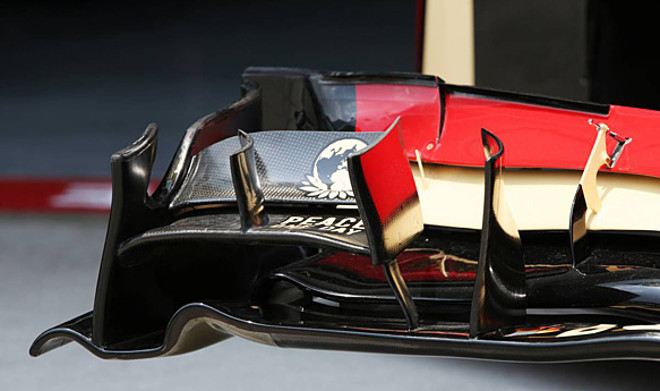

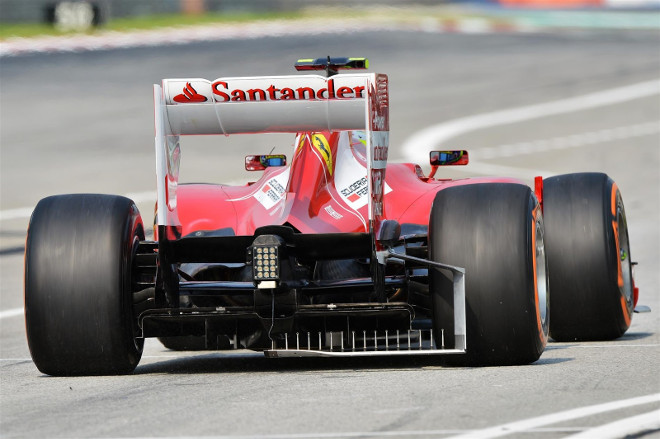

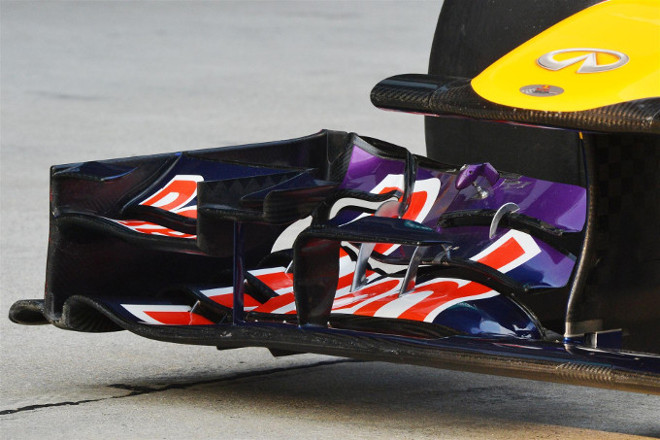
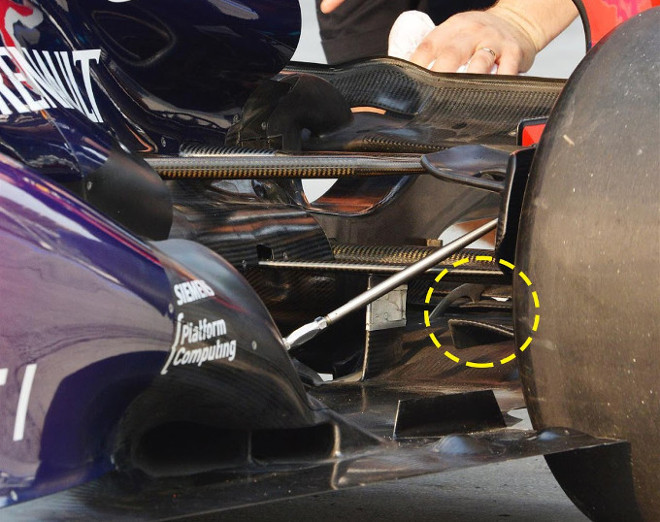


![F1 | Verstappen "upset" after seeing Perez's departure in Miami [VIDEO]](https://f1grandprix.motorionline.com/wp-content/uploads/2024/05/f1-verstappen-partenza-gp-miami-1024x555.jpg)
![F1 | Verstappen "upset" after seeing Perez's departure in Miami [VIDEO]](https://f1grandprix.motorionline.com/wp-content/uploads/2024/05/f1-verstappen-partenza-gp-miami-500x271.jpg)
![F1 | GP Miami, SC changes the balance of the race between Verstappen and Norris: Ivan Capelli's analysis [VIDEO]](https://f1grandprix.motorionline.com/wp-content/uploads/2024/05/f1-gp-miami-norris-mclaren-1024x551.jpg)
![F1 | GP Miami, SC changes the balance of the race between Verstappen and Norris: Ivan Capelli's analysis [VIDEO]](https://f1grandprix.motorionline.com/wp-content/uploads/2024/05/f1-gp-miami-norris-mclaren-500x269.jpg)
![F1 | Ferrari shone in Miami even without updates, optimism grows ahead of Imola [VIDEO]](https://f1grandprix.motorionline.com/wp-content/uploads/2024/05/f1-gp-miami-ferrari-1024x550.jpg)
![F1 | Ferrari shone in Miami even without updates, optimism grows ahead of Imola [VIDEO]](https://f1grandprix.motorionline.com/wp-content/uploads/2024/05/f1-gp-miami-ferrari-500x268.jpg)









